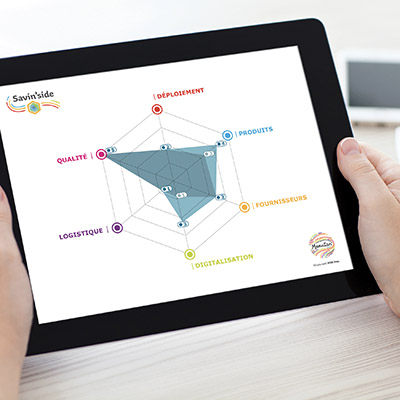Risk management entails identifying, evaluating and controlling potential risks that could impact a company’s objectives. The key challenge is to mitigate these threats while maximising opportunities to ensure business continuity and longevity. In today’s complex and uncertain world, risk management has become an integral part of any successful enterprise.
Risk management: Definition
In the course of its activities, every company is exposed to risks. These are internal or external events to the organisation that can have significant consequences for its operations. Risk management, also known as risk control, aims to identify these threats, evaluate their probability and implement appropriate tactics to mitigate their adverse effects.
According to the Committee of Sponsoring Organizations of the Treadway Commission, enterprise risk management is defined as "a process effected by an entity’s board of directors, management and other personnel, applied in strategy setting and across the enterprise. It is designed to identify potential events that may affect the entity, and manage risks to be within its risk appetite , to provide reasonable assurance regarding the achievement of the entity’s objectives[1]."
The risk management process
Effective risk management follows structured and continuous steps based on four main principles: Risk identification and assessment (i.e., risk analysis) through to the development of appropriate strategies and their management.
Identifying risks
The first step is to identify and describe potential risks the company could be exposed to. This involves identifying all threats to the organisation, its operations and employees. To carry out this identification process effectively, teams need to be consulted, available data studied, and sites visited. This results in a complete inventory of the company’s risks.
Assessing risks
For the identified risks, it is necessary to determine the probability of their occurrence and consider their potential impact (financial, human, reputational, etc.). During this risk evaluation phase, each risk must be considered individually, as well as potential interactions and/or accumulations of risks over time. This leads to the creation of a risk matrix, which allows risks to be prioritised according to their magnitude for better management.
Implementing appropriate strategies
Once the risk assessment is complete, the company is then able to develop appropriate strategies by measuring the cost/benefit ratio. It can focus on risk prevention by avoiding trigger events or minimising their consequences. It can also choose passive corrective action by transferring the repercussions of these risks to third parties, for example. To implement these measures consistently, it often needs to make adjustments to internal processes, invest in technologies or enter into strategic partnerships.
Monitoring and controlling risks
Risk management is a dynamic process. It is therefore essential to implement a system for continuous and/or periodic monitoring, surveillance and control of risks. The aim is to check the effectiveness and relevance of the strategies in place, but also regularly reassessing risks as the environment evolves.
The main types of corporate risks
There are many types of risk that companies face every day. These can be classified by activity, cause, etc.
You will find them grouped in the list below, inspired by the work of K. Lajili and D. Zéghal:
- Financial risk with changes in interest rates, accidents, human errors, changes in competition, loss of market share, etc.
- Regulatory risk linked to changes in control, regulation, national or international legislation;
- Economic risk associated with changes in macroeconomic factors (inflation, employment, income, etc.);
- Risk related to raw materials, inherent in price and/or availability changes;
- Environmental risk with the occurrence of incidents or regulations related to the environment;
- Political risk linked to conducting business in an international context;
- Liquidity risk with difficulties in meeting commitments and/or deadlines;
- Technological risk with the rapid evolution of technologies, but also cyber threats;
- Climate risk such as natural disasters: Floods, cyclones, landslides, etc.;
- Supplier risk such as dependence on strategic suppliers or collaboration with unreliable suppliers.
- Risk related to the cycle, a natural cyclical trend;
- Seasonality risk linked to seasonal patterns;
- Risk of value of the financial instrument;
- Distribution risk linked to changes, disruptions in distribution channels;
- Risk regarding natural resources (water, energy, etc.) including low or insufficient reserve quantities.
All of these risks can compromise the smooth running of operations, financial stability and the competitive position of the company.
Risk management strategies
The company must then apply the right measures to reduce or eliminate risks, as well as their consequences. There are commonly five major risk management tactics, based on risk mitigation and prevention.
Avoiding risks
While they can rarely be completely eliminated, it is nevertheless possible to implement strategies to mitigate risks and even reduce the probability of their occurrence. Risk avoidance involves not participating in activities (product launches, investments, locations, etc.) that could have a negative impact on the business.
Reducing risks
The company can also decide to minimise the consequences of certain risks. It agrees to take the risk but aims to control and prevent the consequences that may arise. Risk reduction often involves reviewing a process, action plan or reducing its scope.
Sharing risks
It is also possible to opt for risk sharing and its consequences with stakeholders. This can be internal to the company or with suppliers, business partners. It is the case when investors pool their capital, with the possibility of failure then spread within a group.
Transferring risks
The business can also decide to contractually transfer the risk to a third party. This is what insurance offers, a fundamental risk management tool. It allows some of the risk to be transferred to an insurance company, with protection against damage and/or significant financial losses.
Accepting risks
Lastly, the remaining risk management strategy is to accept them, while putting in place a robust crisis management plan. The company can decide that the business opportunity is worth it and thus agree to manage the possible consequences. In any case, some residual risk will always remain.
Risk analysis and management provide valuable assistance in making the right decisions, solving key problems and managing crises that arise within the company. It is thanks to this approach that decision-makers can guide their organisation towards a more stable and prosperous future. Moreover, risk management is not only a response to threats, but also an opportunity to innovate and develop in an ever-changing environment.
[1] Enterprise Risk Management, Committee of Sponsoring Organizations of the Treadway Commission (COSO), 2004









